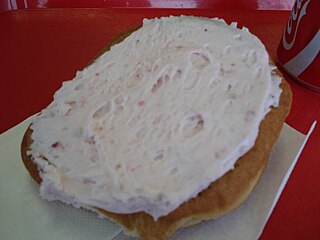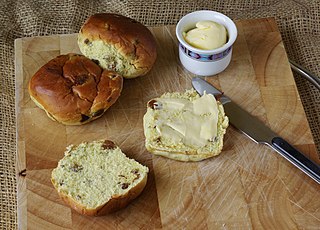
A bun is a non-sweet bread roll, typically filled with savory fillings. A bun may also refer to a sweet cake in certain parts of the world. Though they come in many shapes and sizes, buns are most commonly round, and are generally hand-sized or smaller.
A spiced bun is a sweet bun to which spices were added during the making process. Common examples are the hot cross bun and the Jamaican spiced bun.

A wedding cake is the traditional cake served at wedding receptions following dinner. In some parts of England, the wedding cake is served at a wedding breakfast; the 'wedding breakfast' does not mean the meal will be held in the morning, but at a time following the ceremony on the same day. In modern Western culture, the cake is usually on display and served to guests at the reception. Traditionally, wedding cakes were made to bring good luck to all guests and the couple. Nowadays, however, they are more of a centerpiece to the wedding and are not always even served to the guests. Some cakes are built with only a single edible tier for the bride and groom to share, but this is rare since the cost difference between fake and real tiers is minimal.

A mille-feuille, also known by the names Napoleon, vanilla slice, and custard slice, is a dessert made of puff pastry layered with pastry cream. Its modern form was influenced by improvements made by Marie-Antoine Carême.

An Empire biscuit is a sweet biscuit eaten in Scotland, and other Commonwealth countries. It is popular in Northern Ireland, and it is an iconic dish in Winnipeg, Canada.

Christmas cake is a type of cake, often fruitcake, served at Christmas time in many countries.

A teacake in England is generally a light yeast-based sweet bun containing dried fruit, typically served toasted and buttered. In the U.S. teacakes can be cookies or small cakes. In Sweden, they are soft, round, flat wheat breads made with milk and a little sugar, and used to make buttered ham or cheese sandwiches. In India and Australia, a teacake is more like a butter cake. Tea refers to the popular beverage to which these baked goods are an accompaniment.

The Bath bun is a sweet roll made from a milk-based yeast dough with crushed sugar sprinkled on top after baking. Variations in ingredients include enclosing a lump of sugar in the bun or adding candied fruit peel, currants, raisins or sultanas.

The Chelsea bun is a type of currant bun that was first baked in the 18th century at the Bun House in Chelsea, an establishment favoured by Hanoverian royalty accustomed to similar pastries in their native cuisine. The shop was demolished in 1839.

A saffron bun, Cornish tea treat bun or revel bun, is a rich, spiced yeast-leavened sweet bun that is flavoured with saffron and contains dried fruit including currants and raisins similar to a teacake. The main ingredients are plain flour, butter, yeast, caster sugar, currants and sultanas. Larger versions baked in a loaf tin are known as saffron cake.

A Persian, Persian roll or Pershing is a fried sweet roll or doughnut with a spiral shape similar to a cinnamon bun. It may be covered with a sugar glaze, iced or frosted, or sprinkled with sugar or cinnamon sugar.

Cake decorating is the art of decorating a cake for special occasions such as birthdays, weddings, national or religious holidays, or as a promotional item. It is a form of sugar art that uses materials such as icing, fondant, and other edible decorations. Cake decoration has been featured on TV channels such as TLC, Food Network, and Discovery Family as a form of entertainment. An artisan may take on simple or elaborate three-dimensional shapes as part of decoration or the cake in its entirety. Chocolate is commonly used to decorate cakes, as it can be melted and mixed with cream to make a ganache or cocoa powder can be lightly dusted on top of a cake.
An iced bun is a bread bun with a white or pink icing sugar glaze covering the top. The dough may be enriched or simply an oblong bread roll. In some bakeries or recipes, iced buns are garnished with additional sweets or are decorated as ballet slippers or other shapes.

Cardamom breads, including the Finnish pulla and Swedish kardemummabröd and kardemummabullar, are a group of enriched breads or pastry flavored with cardamom. They are eaten throughout the year, typically with coffee or tea.

A currant bun is a European sweet bun that contains currants or raisins.

Sponge cake is a light cake made with egg whites, flour and sugar, sometimes leavened with baking powder. Sponge cakes, leavened with beaten eggs, originated during the Renaissance, possibly in Spain. The sponge cake is thought to be one of the first of the non-yeasted cakes, and the earliest attested sponge cake recipe in English is found in a book by the English poet Gervase Markham, The English Huswife, Containing the Inward and Outward Virtues Which Ought to Be in a Complete Woman (1615). Still, the cake was much more like a cracker: thin and crispy. Sponge cakes became the cake recognized today when bakers started using beaten eggs as a rising agent in the mid-18th century. The Victorian creation of baking powder by English food manufacturer Alfred Bird in 1843 allowed the addition of butter to the traditional sponge recipe, resulting in the creation of the Victoria sponge.













